SWSP1043 - Analysis of Contrasting Policy Approaches to Social Ills
VerifiedAdded on 2023/06/12
|9
|3019
|212
Report
AI Summary
This report provides an analysis of contrasting policy approaches to address social problems, focusing on drug-related societal concerns. It examines the Narcotic Drugs Act of 1967 and the Criminal Code Act of 1995, highlighting the debates surrounding these policies. The report assesses the effectiveness of each approach, considering their theoretical underpinnings, social values, and human rights implications. It critiques the circumstances under which each policy approach could be considered appropriate or inappropriate, ultimately evaluating which approach is more helpful in addressing the key social issue of drug addiction. The analysis includes a review of government theories, societal values, and evidence-based assessments, emphasizing the importance of collaboration between agencies, municipalities, and various sectors of society to achieve long-term goals in addressing drug-related issues. Desklib offers a platform for students to access this and similar assignments for study purposes.

Report
Paraphrase This Document
Need a fresh take? Get an instant paraphrase of this document with our AI Paraphraser
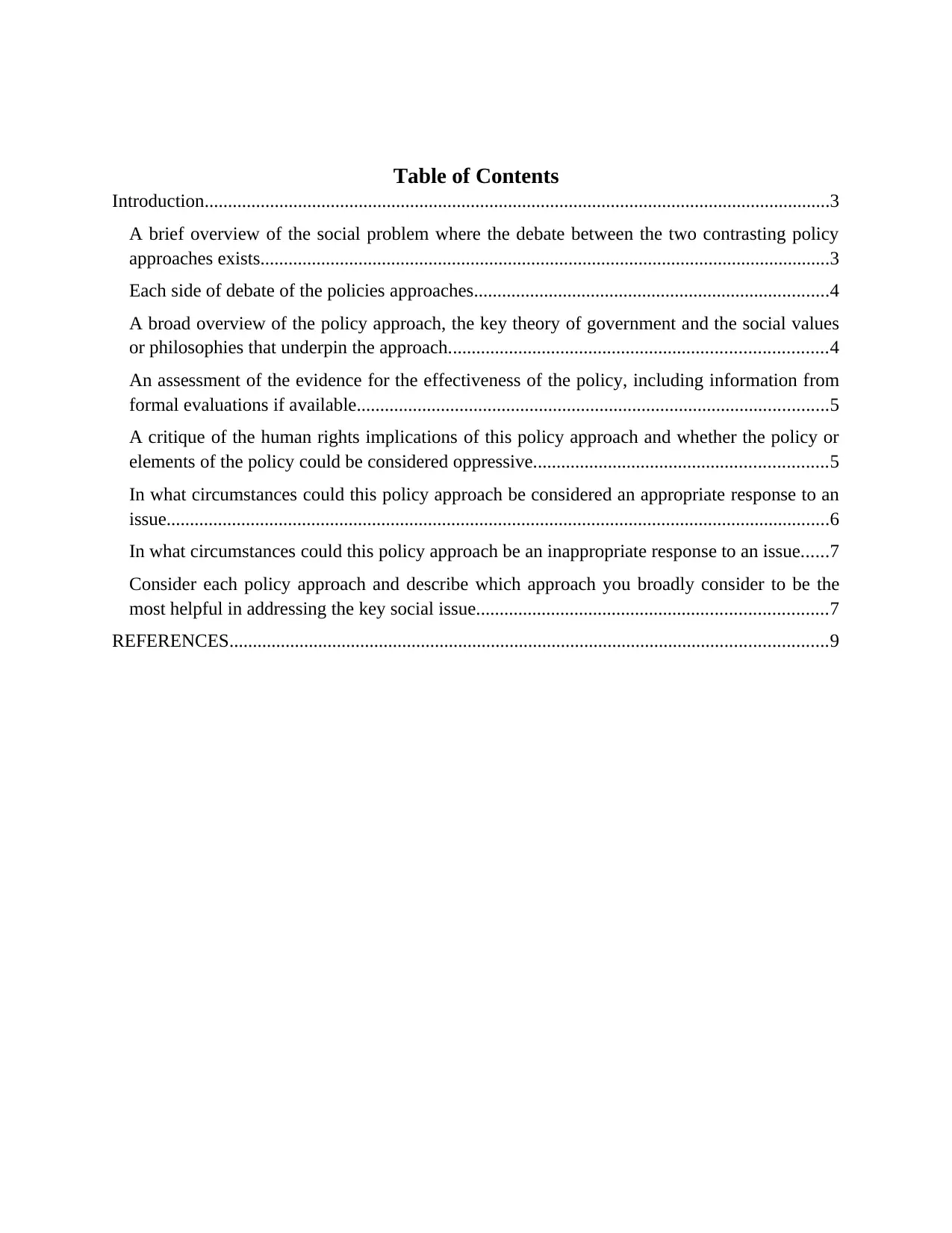
Table of Contents
Introduction......................................................................................................................................3
A brief overview of the social problem where the debate between the two contrasting policy
approaches exists..........................................................................................................................3
Each side of debate of the policies approaches............................................................................4
A broad overview of the policy approach, the key theory of government and the social values
or philosophies that underpin the approach.................................................................................4
An assessment of the evidence for the effectiveness of the policy, including information from
formal evaluations if available.....................................................................................................5
A critique of the human rights implications of this policy approach and whether the policy or
elements of the policy could be considered oppressive...............................................................5
In what circumstances could this policy approach be considered an appropriate response to an
issue..............................................................................................................................................6
In what circumstances could this policy approach be an inappropriate response to an issue......7
Consider each policy approach and describe which approach you broadly consider to be the
most helpful in addressing the key social issue...........................................................................7
REFERENCES................................................................................................................................9
Introduction......................................................................................................................................3
A brief overview of the social problem where the debate between the two contrasting policy
approaches exists..........................................................................................................................3
Each side of debate of the policies approaches............................................................................4
A broad overview of the policy approach, the key theory of government and the social values
or philosophies that underpin the approach.................................................................................4
An assessment of the evidence for the effectiveness of the policy, including information from
formal evaluations if available.....................................................................................................5
A critique of the human rights implications of this policy approach and whether the policy or
elements of the policy could be considered oppressive...............................................................5
In what circumstances could this policy approach be considered an appropriate response to an
issue..............................................................................................................................................6
In what circumstances could this policy approach be an inappropriate response to an issue......7
Consider each policy approach and describe which approach you broadly consider to be the
most helpful in addressing the key social issue...........................................................................7
REFERENCES................................................................................................................................9
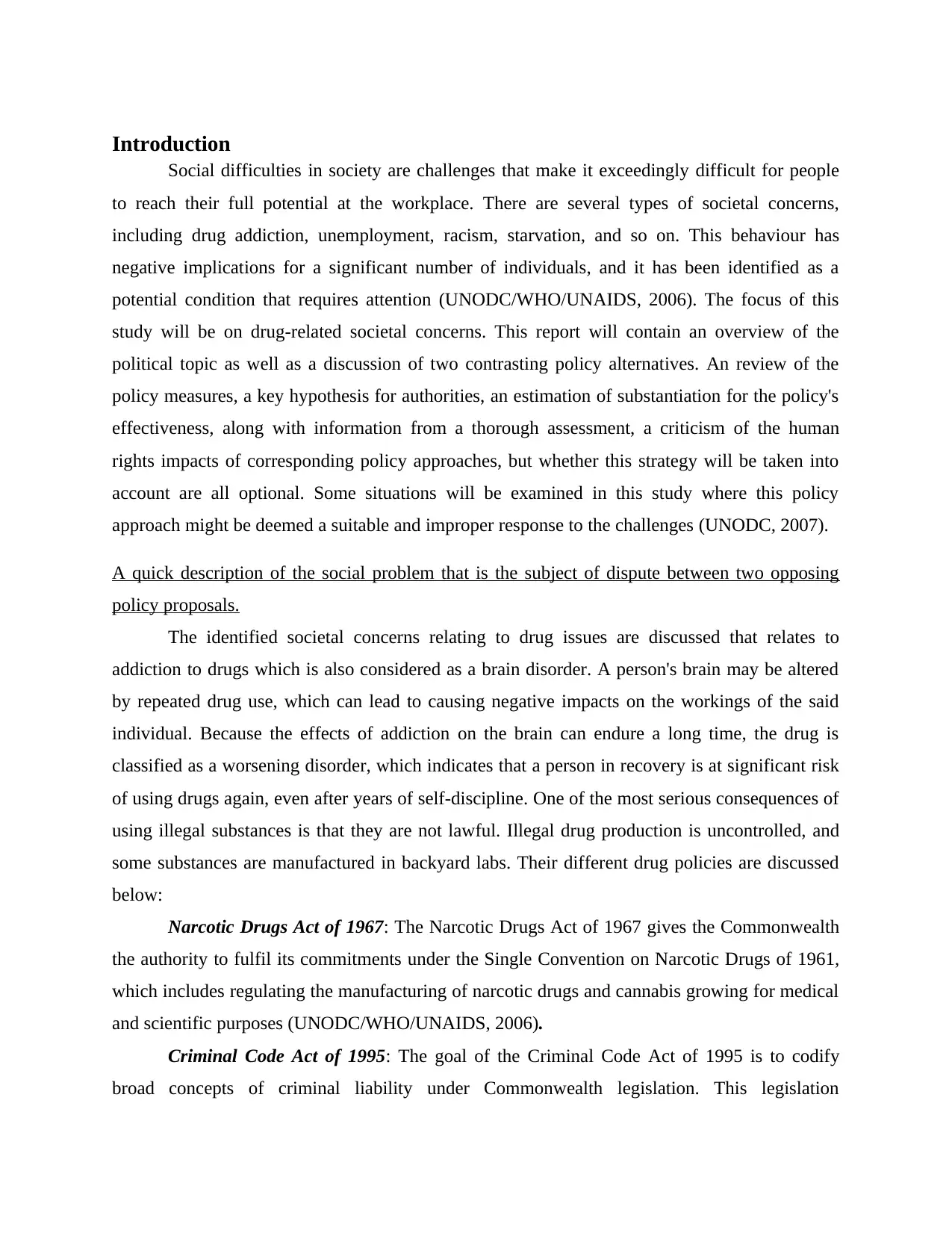
Introduction
Social difficulties in society are challenges that make it exceedingly difficult for people
to reach their full potential at the workplace. There are several types of societal concerns,
including drug addiction, unemployment, racism, starvation, and so on. This behaviour has
negative implications for a significant number of individuals, and it has been identified as a
potential condition that requires attention (UNODC/WHO/UNAIDS, 2006). The focus of this
study will be on drug-related societal concerns. This report will contain an overview of the
political topic as well as a discussion of two contrasting policy alternatives. An review of the
policy measures, a key hypothesis for authorities, an estimation of substantiation for the policy's
effectiveness, along with information from a thorough assessment, a criticism of the human
rights impacts of corresponding policy approaches, but whether this strategy will be taken into
account are all optional. Some situations will be examined in this study where this policy
approach might be deemed a suitable and improper response to the challenges (UNODC, 2007).
A quick description of the social problem that is the subject of dispute between two opposing
policy proposals.
The identified societal concerns relating to drug issues are discussed that relates to
addiction to drugs which is also considered as a brain disorder. A person's brain may be altered
by repeated drug use, which can lead to causing negative impacts on the workings of the said
individual. Because the effects of addiction on the brain can endure a long time, the drug is
classified as a worsening disorder, which indicates that a person in recovery is at significant risk
of using drugs again, even after years of self-discipline. One of the most serious consequences of
using illegal substances is that they are not lawful. Illegal drug production is uncontrolled, and
some substances are manufactured in backyard labs. Their different drug policies are discussed
below:
Narcotic Drugs Act of 1967: The Narcotic Drugs Act of 1967 gives the Commonwealth
the authority to fulfil its commitments under the Single Convention on Narcotic Drugs of 1961,
which includes regulating the manufacturing of narcotic drugs and cannabis growing for medical
and scientific purposes (UNODC/WHO/UNAIDS, 2006).
Criminal Code Act of 1995: The goal of the Criminal Code Act of 1995 is to codify
broad concepts of criminal liability under Commonwealth legislation. This legislation
Social difficulties in society are challenges that make it exceedingly difficult for people
to reach their full potential at the workplace. There are several types of societal concerns,
including drug addiction, unemployment, racism, starvation, and so on. This behaviour has
negative implications for a significant number of individuals, and it has been identified as a
potential condition that requires attention (UNODC/WHO/UNAIDS, 2006). The focus of this
study will be on drug-related societal concerns. This report will contain an overview of the
political topic as well as a discussion of two contrasting policy alternatives. An review of the
policy measures, a key hypothesis for authorities, an estimation of substantiation for the policy's
effectiveness, along with information from a thorough assessment, a criticism of the human
rights impacts of corresponding policy approaches, but whether this strategy will be taken into
account are all optional. Some situations will be examined in this study where this policy
approach might be deemed a suitable and improper response to the challenges (UNODC, 2007).
A quick description of the social problem that is the subject of dispute between two opposing
policy proposals.
The identified societal concerns relating to drug issues are discussed that relates to
addiction to drugs which is also considered as a brain disorder. A person's brain may be altered
by repeated drug use, which can lead to causing negative impacts on the workings of the said
individual. Because the effects of addiction on the brain can endure a long time, the drug is
classified as a worsening disorder, which indicates that a person in recovery is at significant risk
of using drugs again, even after years of self-discipline. One of the most serious consequences of
using illegal substances is that they are not lawful. Illegal drug production is uncontrolled, and
some substances are manufactured in backyard labs. Their different drug policies are discussed
below:
Narcotic Drugs Act of 1967: The Narcotic Drugs Act of 1967 gives the Commonwealth
the authority to fulfil its commitments under the Single Convention on Narcotic Drugs of 1961,
which includes regulating the manufacturing of narcotic drugs and cannabis growing for medical
and scientific purposes (UNODC/WHO/UNAIDS, 2006).
Criminal Code Act of 1995: The goal of the Criminal Code Act of 1995 is to codify
broad concepts of criminal liability under Commonwealth legislation. This legislation
⊘ This is a preview!⊘
Do you want full access?
Subscribe today to unlock all pages.

Trusted by 1+ million students worldwide
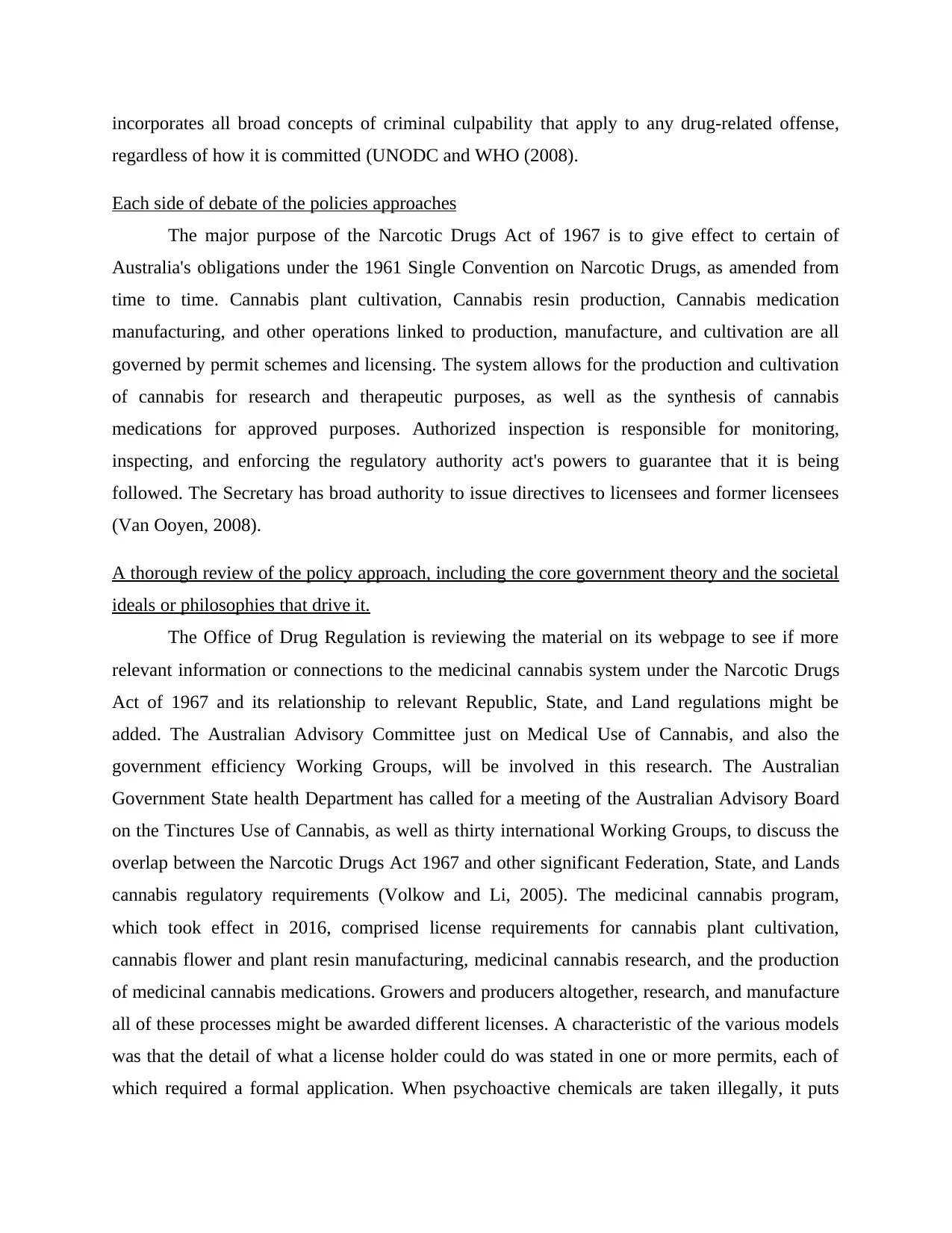
incorporates all broad concepts of criminal culpability that apply to any drug-related offense,
regardless of how it is committed (UNODC and WHO (2008).
Each side of debate of the policies approaches
The major purpose of the Narcotic Drugs Act of 1967 is to give effect to certain of
Australia's obligations under the 1961 Single Convention on Narcotic Drugs, as amended from
time to time. Cannabis plant cultivation, Cannabis resin production, Cannabis medication
manufacturing, and other operations linked to production, manufacture, and cultivation are all
governed by permit schemes and licensing. The system allows for the production and cultivation
of cannabis for research and therapeutic purposes, as well as the synthesis of cannabis
medications for approved purposes. Authorized inspection is responsible for monitoring,
inspecting, and enforcing the regulatory authority act's powers to guarantee that it is being
followed. The Secretary has broad authority to issue directives to licensees and former licensees
(Van Ooyen, 2008).
A thorough review of the policy approach, including the core government theory and the societal
ideals or philosophies that drive it.
The Office of Drug Regulation is reviewing the material on its webpage to see if more
relevant information or connections to the medicinal cannabis system under the Narcotic Drugs
Act of 1967 and its relationship to relevant Republic, State, and Land regulations might be
added. The Australian Advisory Committee just on Medical Use of Cannabis, and also the
government efficiency Working Groups, will be involved in this research. The Australian
Government State health Department has called for a meeting of the Australian Advisory Board
on the Tinctures Use of Cannabis, as well as thirty international Working Groups, to discuss the
overlap between the Narcotic Drugs Act 1967 and other significant Federation, State, and Lands
cannabis regulatory requirements (Volkow and Li, 2005). The medicinal cannabis program,
which took effect in 2016, comprised license requirements for cannabis plant cultivation,
cannabis flower and plant resin manufacturing, medicinal cannabis research, and the production
of medicinal cannabis medications. Growers and producers altogether, research, and manufacture
all of these processes might be awarded different licenses. A characteristic of the various models
was that the detail of what a license holder could do was stated in one or more permits, each of
which required a formal application. When psychoactive chemicals are taken illegally, it puts
regardless of how it is committed (UNODC and WHO (2008).
Each side of debate of the policies approaches
The major purpose of the Narcotic Drugs Act of 1967 is to give effect to certain of
Australia's obligations under the 1961 Single Convention on Narcotic Drugs, as amended from
time to time. Cannabis plant cultivation, Cannabis resin production, Cannabis medication
manufacturing, and other operations linked to production, manufacture, and cultivation are all
governed by permit schemes and licensing. The system allows for the production and cultivation
of cannabis for research and therapeutic purposes, as well as the synthesis of cannabis
medications for approved purposes. Authorized inspection is responsible for monitoring,
inspecting, and enforcing the regulatory authority act's powers to guarantee that it is being
followed. The Secretary has broad authority to issue directives to licensees and former licensees
(Van Ooyen, 2008).
A thorough review of the policy approach, including the core government theory and the societal
ideals or philosophies that drive it.
The Office of Drug Regulation is reviewing the material on its webpage to see if more
relevant information or connections to the medicinal cannabis system under the Narcotic Drugs
Act of 1967 and its relationship to relevant Republic, State, and Land regulations might be
added. The Australian Advisory Committee just on Medical Use of Cannabis, and also the
government efficiency Working Groups, will be involved in this research. The Australian
Government State health Department has called for a meeting of the Australian Advisory Board
on the Tinctures Use of Cannabis, as well as thirty international Working Groups, to discuss the
overlap between the Narcotic Drugs Act 1967 and other significant Federation, State, and Lands
cannabis regulatory requirements (Volkow and Li, 2005). The medicinal cannabis program,
which took effect in 2016, comprised license requirements for cannabis plant cultivation,
cannabis flower and plant resin manufacturing, medicinal cannabis research, and the production
of medicinal cannabis medications. Growers and producers altogether, research, and manufacture
all of these processes might be awarded different licenses. A characteristic of the various models
was that the detail of what a license holder could do was stated in one or more permits, each of
which required a formal application. When psychoactive chemicals are taken illegally, it puts
Paraphrase This Document
Need a fresh take? Get an instant paraphrase of this document with our AI Paraphraser

people's and society's health at risk. It alters one's behaviour and emotions, and it has the
potential to lead to serious psychiatric issues. These medicines can create addiction and a loss of
interest in a number of activities due to their effects on the brain. Drugs are placed under national
and international regulation to avoid the detrimental health and social effects of substance usage.
The International Narcotics Control Board (INCB) recognised harm reduction as a component of
a tertiary preventive approach for demand reduction in 1993 (Wild, 2006). While harm reduction
programmes can assist reduce overall medical demand, the Board cautioned that they should not
be used in place of or as a substitute for other vital occupations aimed at reducing illicit drug
requires, such as preventive and treatment projects. The government hopes to create a long-term
perspective as well as improved collaboration and coordination between agencies and other
parties by adopting a five-year cohesive plan. It also wants to stress the significance of
everyone's contribution to the process. Action by agencies, municipalities and county
governments, the business community, non-governmental organisations, and other civil society
sectors will be required if the Advanced Institute of Nondestructive Testing & Training (ANDT)
policy goals are to be met in accordance with the plan. According with government,
collaboration in the fields of health awareness, treatment, police departments, treatment, and
rehabilitative should be strengthened (UNODC/WHO/UNAIDS, 2006).
An analysis of the evidence supporting the policy's success, including data from official
assessments if available
The strategy's overall challenge is to create state financial assistance operations in the
ANDT area simpler. For the years 2011–2015, the plan sets the goals, aims, and purpose of
governmental policy. Themes addressed include local prevention, supply-side efforts, drug
regulation, treatment and care, alcohol and tobacco tracking, and EU and diplomatic agencies.
Aside from the core aim, the strategy contains seven long-term goals that are crucial in the
longterm. Some are tied to a number of significant issue goals and targets during the design
process, which will last through till end of 2015 (World Health Organization, 2013).
A critique of the policy approach's human rights implications, as well as whether the policy or
aspects of the policy might be considered repressive.
Crime and ANDT prevention initiatives must be performed out on a local level by those
who are most aware of the challenges in the community. Police, schools, social services, non-
potential to lead to serious psychiatric issues. These medicines can create addiction and a loss of
interest in a number of activities due to their effects on the brain. Drugs are placed under national
and international regulation to avoid the detrimental health and social effects of substance usage.
The International Narcotics Control Board (INCB) recognised harm reduction as a component of
a tertiary preventive approach for demand reduction in 1993 (Wild, 2006). While harm reduction
programmes can assist reduce overall medical demand, the Board cautioned that they should not
be used in place of or as a substitute for other vital occupations aimed at reducing illicit drug
requires, such as preventive and treatment projects. The government hopes to create a long-term
perspective as well as improved collaboration and coordination between agencies and other
parties by adopting a five-year cohesive plan. It also wants to stress the significance of
everyone's contribution to the process. Action by agencies, municipalities and county
governments, the business community, non-governmental organisations, and other civil society
sectors will be required if the Advanced Institute of Nondestructive Testing & Training (ANDT)
policy goals are to be met in accordance with the plan. According with government,
collaboration in the fields of health awareness, treatment, police departments, treatment, and
rehabilitative should be strengthened (UNODC/WHO/UNAIDS, 2006).
An analysis of the evidence supporting the policy's success, including data from official
assessments if available
The strategy's overall challenge is to create state financial assistance operations in the
ANDT area simpler. For the years 2011–2015, the plan sets the goals, aims, and purpose of
governmental policy. Themes addressed include local prevention, supply-side efforts, drug
regulation, treatment and care, alcohol and tobacco tracking, and EU and diplomatic agencies.
Aside from the core aim, the strategy contains seven long-term goals that are crucial in the
longterm. Some are tied to a number of significant issue goals and targets during the design
process, which will last through till end of 2015 (World Health Organization, 2013).
A critique of the policy approach's human rights implications, as well as whether the policy or
aspects of the policy might be considered repressive.
Crime and ANDT prevention initiatives must be performed out on a local level by those
who are most aware of the challenges in the community. Police, schools, social services, non-

governmental organisations, and the private sector all play important roles. Local participants in
various jobs in the society, according to knowledge, may add value by working to prevent
criminality and boost personal protection. The maternal care program has been effective in
reducing ANDT-related harm during infertility for many years. Physician and midwifery training
courses were critical in this approach, and more of this training should be promoted in the future.
Parents who are expecting a child have a right to receive information about the hazards of
ANDT. As a result, it is critical to preserve the current network of maternity and paediatric
healthcare services. There has to be a better awareness that children in homes with bad
behaviour, mental illness, or psychological issues may require special attention from agencies
that deal with all of these other kids (World Health Organization, 2014). When dealing with
parents who face issues like these, staff must be aware of their responsibilities as well as the
different aid options available. It is critical to intervene on behalf of children in houses where
there is violence, mental illness, or mental impairment. Children must never be left in risky
situations without the assistance of the community. Furthermore, doing so as a society lowers the
risk of vulnerable students having mental health and substance abuse issues later in life. Possible
improvements in detecting and aiming to find out to at-risk children and their parents should be
created in order to make sure that each particular youngster receives support
(UNODC/WHO/UNAIDS, 2006).
In what conditions would this policy approach be deemed a viable solution to a problem?
These will be no changes to the current competency allocation in Government Offices or
among relevant agencies as a result of the Advanced Institute of Nondestructive Testing &
Training approach. ANDT policy will be coordinated by the Ministry of Health and Social
Affairs. The current cross-sectoral regional and national structure will be kept and supplemented
with a strictly delineated structure for follow-up and evaluation with the goal of increasing
ANDT coordination. The ANDT Review Panel, the Government's expert committee on alcohol,
narcotic drugs, doping, and tobacco problems, is another important component of a
comprehensive coordinating function. The council plays a critical role in enhancing public
awareness of government policy goals and actions in the field of ANDT. Its operations will be
more closely aligned with the strategy's approach in order to improve collaboration in support of
the strategy's seven long-term goals (UNODC/WHO/UNAIDS, 2006).
various jobs in the society, according to knowledge, may add value by working to prevent
criminality and boost personal protection. The maternal care program has been effective in
reducing ANDT-related harm during infertility for many years. Physician and midwifery training
courses were critical in this approach, and more of this training should be promoted in the future.
Parents who are expecting a child have a right to receive information about the hazards of
ANDT. As a result, it is critical to preserve the current network of maternity and paediatric
healthcare services. There has to be a better awareness that children in homes with bad
behaviour, mental illness, or psychological issues may require special attention from agencies
that deal with all of these other kids (World Health Organization, 2014). When dealing with
parents who face issues like these, staff must be aware of their responsibilities as well as the
different aid options available. It is critical to intervene on behalf of children in houses where
there is violence, mental illness, or mental impairment. Children must never be left in risky
situations without the assistance of the community. Furthermore, doing so as a society lowers the
risk of vulnerable students having mental health and substance abuse issues later in life. Possible
improvements in detecting and aiming to find out to at-risk children and their parents should be
created in order to make sure that each particular youngster receives support
(UNODC/WHO/UNAIDS, 2006).
In what conditions would this policy approach be deemed a viable solution to a problem?
These will be no changes to the current competency allocation in Government Offices or
among relevant agencies as a result of the Advanced Institute of Nondestructive Testing &
Training approach. ANDT policy will be coordinated by the Ministry of Health and Social
Affairs. The current cross-sectoral regional and national structure will be kept and supplemented
with a strictly delineated structure for follow-up and evaluation with the goal of increasing
ANDT coordination. The ANDT Review Panel, the Government's expert committee on alcohol,
narcotic drugs, doping, and tobacco problems, is another important component of a
comprehensive coordinating function. The council plays a critical role in enhancing public
awareness of government policy goals and actions in the field of ANDT. Its operations will be
more closely aligned with the strategy's approach in order to improve collaboration in support of
the strategy's seven long-term goals (UNODC/WHO/UNAIDS, 2006).
⊘ This is a preview!⊘
Do you want full access?
Subscribe today to unlock all pages.

Trusted by 1+ million students worldwide
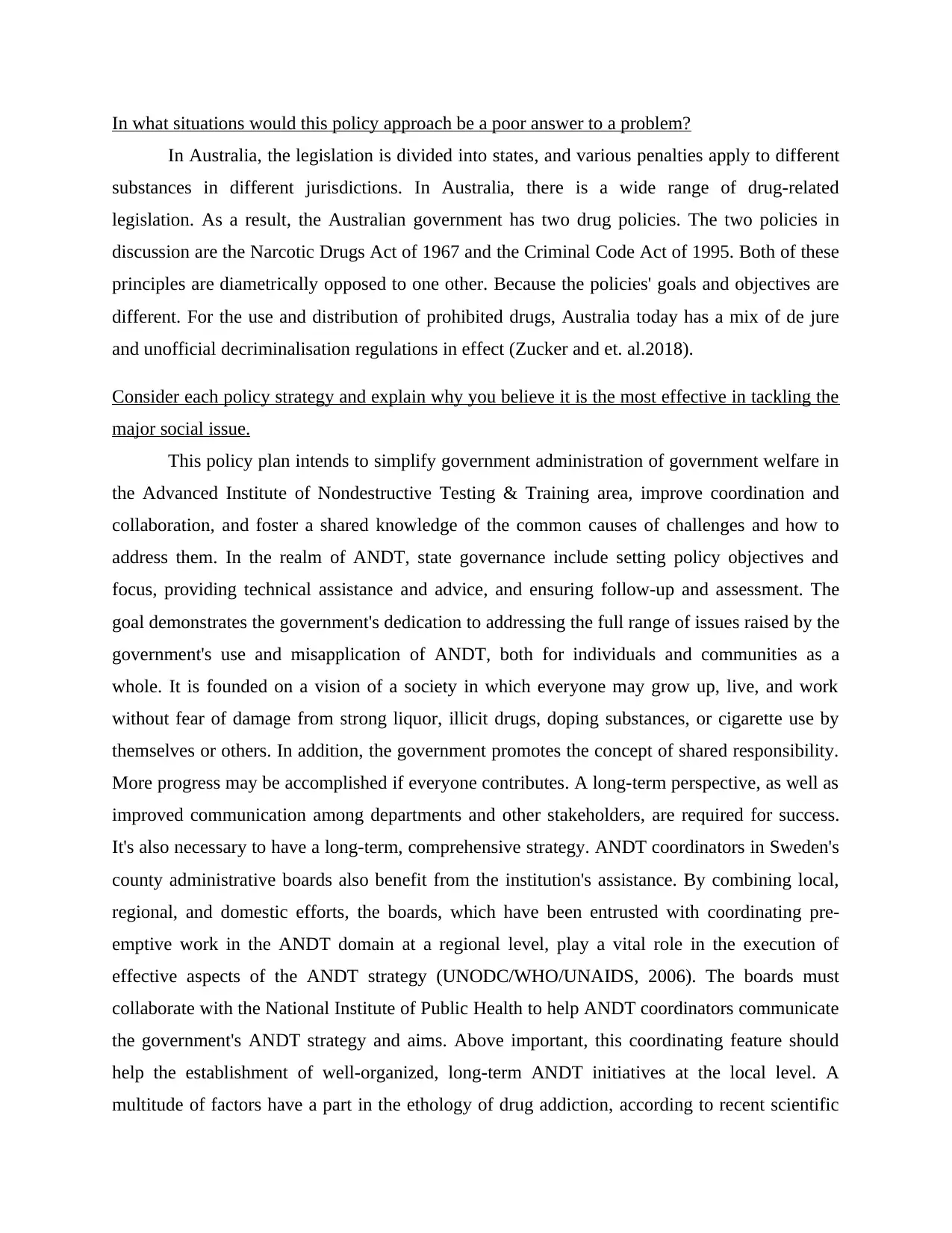
In what situations would this policy approach be a poor answer to a problem?
In Australia, the legislation is divided into states, and various penalties apply to different
substances in different jurisdictions. In Australia, there is a wide range of drug-related
legislation. As a result, the Australian government has two drug policies. The two policies in
discussion are the Narcotic Drugs Act of 1967 and the Criminal Code Act of 1995. Both of these
principles are diametrically opposed to one other. Because the policies' goals and objectives are
different. For the use and distribution of prohibited drugs, Australia today has a mix of de jure
and unofficial decriminalisation regulations in effect (Zucker and et. al.2018).
Consider each policy strategy and explain why you believe it is the most effective in tackling the
major social issue.
This policy plan intends to simplify government administration of government welfare in
the Advanced Institute of Nondestructive Testing & Training area, improve coordination and
collaboration, and foster a shared knowledge of the common causes of challenges and how to
address them. In the realm of ANDT, state governance include setting policy objectives and
focus, providing technical assistance and advice, and ensuring follow-up and assessment. The
goal demonstrates the government's dedication to addressing the full range of issues raised by the
government's use and misapplication of ANDT, both for individuals and communities as a
whole. It is founded on a vision of a society in which everyone may grow up, live, and work
without fear of damage from strong liquor, illicit drugs, doping substances, or cigarette use by
themselves or others. In addition, the government promotes the concept of shared responsibility.
More progress may be accomplished if everyone contributes. A long-term perspective, as well as
improved communication among departments and other stakeholders, are required for success.
It's also necessary to have a long-term, comprehensive strategy. ANDT coordinators in Sweden's
county administrative boards also benefit from the institution's assistance. By combining local,
regional, and domestic efforts, the boards, which have been entrusted with coordinating pre-
emptive work in the ANDT domain at a regional level, play a vital role in the execution of
effective aspects of the ANDT strategy (UNODC/WHO/UNAIDS, 2006). The boards must
collaborate with the National Institute of Public Health to help ANDT coordinators communicate
the government's ANDT strategy and aims. Above important, this coordinating feature should
help the establishment of well-organized, long-term ANDT initiatives at the local level. A
multitude of factors have a part in the ethology of drug addiction, according to recent scientific
In Australia, the legislation is divided into states, and various penalties apply to different
substances in different jurisdictions. In Australia, there is a wide range of drug-related
legislation. As a result, the Australian government has two drug policies. The two policies in
discussion are the Narcotic Drugs Act of 1967 and the Criminal Code Act of 1995. Both of these
principles are diametrically opposed to one other. Because the policies' goals and objectives are
different. For the use and distribution of prohibited drugs, Australia today has a mix of de jure
and unofficial decriminalisation regulations in effect (Zucker and et. al.2018).
Consider each policy strategy and explain why you believe it is the most effective in tackling the
major social issue.
This policy plan intends to simplify government administration of government welfare in
the Advanced Institute of Nondestructive Testing & Training area, improve coordination and
collaboration, and foster a shared knowledge of the common causes of challenges and how to
address them. In the realm of ANDT, state governance include setting policy objectives and
focus, providing technical assistance and advice, and ensuring follow-up and assessment. The
goal demonstrates the government's dedication to addressing the full range of issues raised by the
government's use and misapplication of ANDT, both for individuals and communities as a
whole. It is founded on a vision of a society in which everyone may grow up, live, and work
without fear of damage from strong liquor, illicit drugs, doping substances, or cigarette use by
themselves or others. In addition, the government promotes the concept of shared responsibility.
More progress may be accomplished if everyone contributes. A long-term perspective, as well as
improved communication among departments and other stakeholders, are required for success.
It's also necessary to have a long-term, comprehensive strategy. ANDT coordinators in Sweden's
county administrative boards also benefit from the institution's assistance. By combining local,
regional, and domestic efforts, the boards, which have been entrusted with coordinating pre-
emptive work in the ANDT domain at a regional level, play a vital role in the execution of
effective aspects of the ANDT strategy (UNODC/WHO/UNAIDS, 2006). The boards must
collaborate with the National Institute of Public Health to help ANDT coordinators communicate
the government's ANDT strategy and aims. Above important, this coordinating feature should
help the establishment of well-organized, long-term ANDT initiatives at the local level. A
multitude of factors have a part in the ethology of drug addiction, according to recent scientific
Paraphrase This Document
Need a fresh take? Get an instant paraphrase of this document with our AI Paraphraser
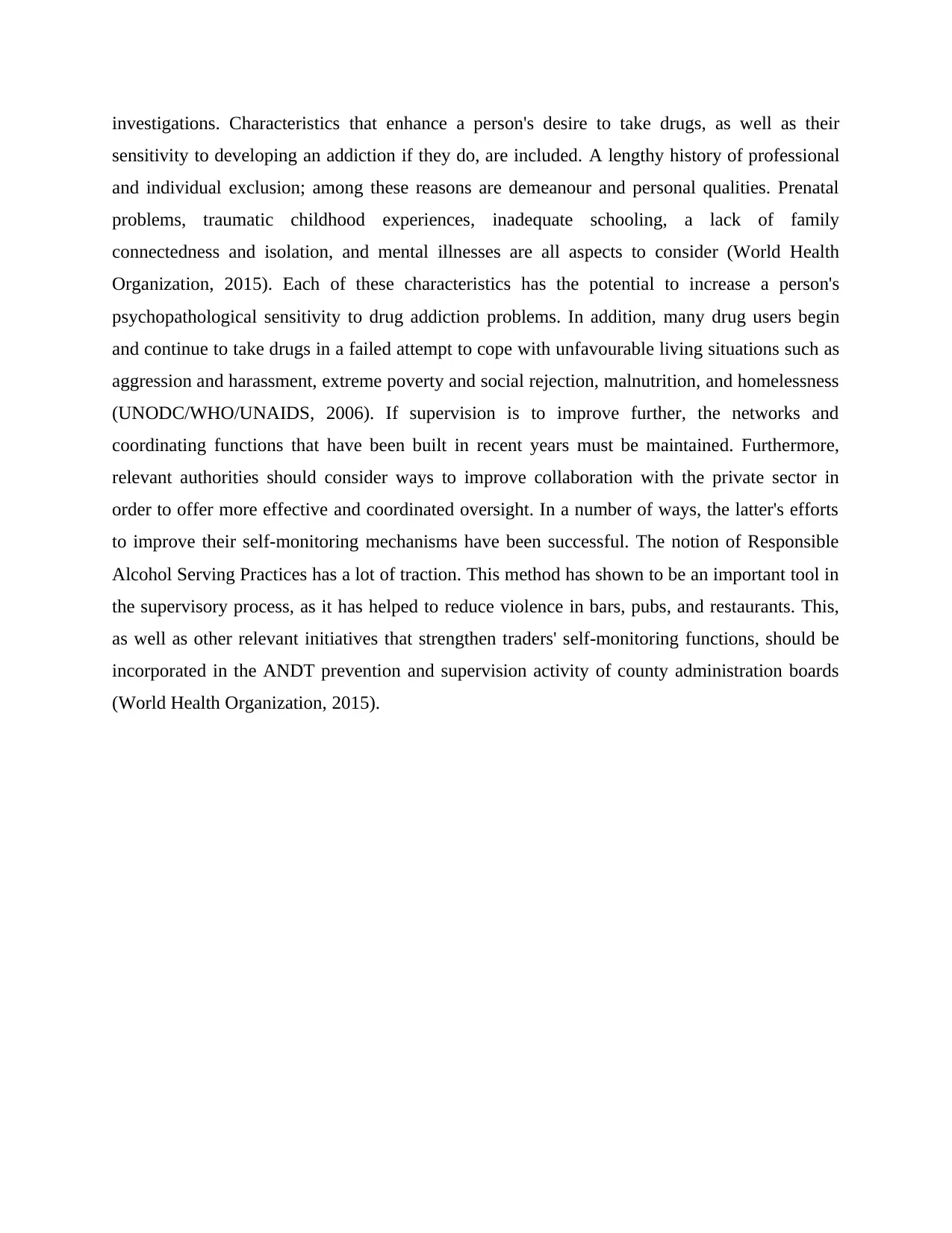
investigations. Characteristics that enhance a person's desire to take drugs, as well as their
sensitivity to developing an addiction if they do, are included. A lengthy history of professional
and individual exclusion; among these reasons are demeanour and personal qualities. Prenatal
problems, traumatic childhood experiences, inadequate schooling, a lack of family
connectedness and isolation, and mental illnesses are all aspects to consider (World Health
Organization, 2015). Each of these characteristics has the potential to increase a person's
psychopathological sensitivity to drug addiction problems. In addition, many drug users begin
and continue to take drugs in a failed attempt to cope with unfavourable living situations such as
aggression and harassment, extreme poverty and social rejection, malnutrition, and homelessness
(UNODC/WHO/UNAIDS, 2006). If supervision is to improve further, the networks and
coordinating functions that have been built in recent years must be maintained. Furthermore,
relevant authorities should consider ways to improve collaboration with the private sector in
order to offer more effective and coordinated oversight. In a number of ways, the latter's efforts
to improve their self-monitoring mechanisms have been successful. The notion of Responsible
Alcohol Serving Practices has a lot of traction. This method has shown to be an important tool in
the supervisory process, as it has helped to reduce violence in bars, pubs, and restaurants. This,
as well as other relevant initiatives that strengthen traders' self-monitoring functions, should be
incorporated in the ANDT prevention and supervision activity of county administration boards
(World Health Organization, 2015).
sensitivity to developing an addiction if they do, are included. A lengthy history of professional
and individual exclusion; among these reasons are demeanour and personal qualities. Prenatal
problems, traumatic childhood experiences, inadequate schooling, a lack of family
connectedness and isolation, and mental illnesses are all aspects to consider (World Health
Organization, 2015). Each of these characteristics has the potential to increase a person's
psychopathological sensitivity to drug addiction problems. In addition, many drug users begin
and continue to take drugs in a failed attempt to cope with unfavourable living situations such as
aggression and harassment, extreme poverty and social rejection, malnutrition, and homelessness
(UNODC/WHO/UNAIDS, 2006). If supervision is to improve further, the networks and
coordinating functions that have been built in recent years must be maintained. Furthermore,
relevant authorities should consider ways to improve collaboration with the private sector in
order to offer more effective and coordinated oversight. In a number of ways, the latter's efforts
to improve their self-monitoring mechanisms have been successful. The notion of Responsible
Alcohol Serving Practices has a lot of traction. This method has shown to be an important tool in
the supervisory process, as it has helped to reduce violence in bars, pubs, and restaurants. This,
as well as other relevant initiatives that strengthen traders' self-monitoring functions, should be
incorporated in the ANDT prevention and supervision activity of county administration boards
(World Health Organization, 2015).
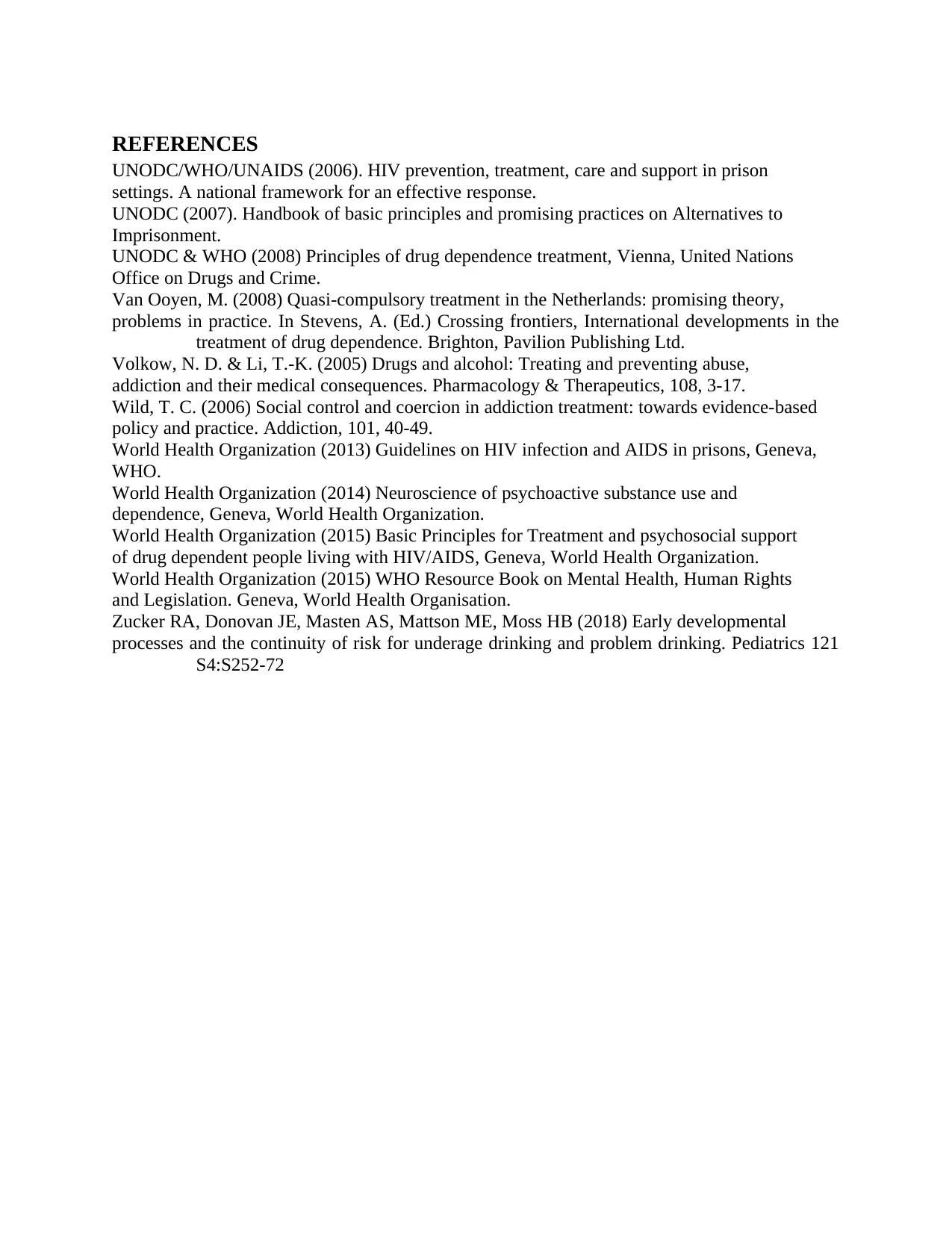
REFERENCES
UNODC/WHO/UNAIDS (2006). HIV prevention, treatment, care and support in prison
settings. A national framework for an effective response.
UNODC (2007). Handbook of basic principles and promising practices on Alternatives to
Imprisonment.
UNODC & WHO (2008) Principles of drug dependence treatment, Vienna, United Nations
Office on Drugs and Crime.
Van Ooyen, M. (2008) Quasi-compulsory treatment in the Netherlands: promising theory,
problems in practice. In Stevens, A. (Ed.) Crossing frontiers, International developments in the
treatment of drug dependence. Brighton, Pavilion Publishing Ltd.
Volkow, N. D. & Li, T.-K. (2005) Drugs and alcohol: Treating and preventing abuse,
addiction and their medical consequences. Pharmacology & Therapeutics, 108, 3-17.
Wild, T. C. (2006) Social control and coercion in addiction treatment: towards evidence-based
policy and practice. Addiction, 101, 40-49.
World Health Organization (2013) Guidelines on HIV infection and AIDS in prisons, Geneva,
WHO.
World Health Organization (2014) Neuroscience of psychoactive substance use and
dependence, Geneva, World Health Organization.
World Health Organization (2015) Basic Principles for Treatment and psychosocial support
of drug dependent people living with HIV/AIDS, Geneva, World Health Organization.
World Health Organization (2015) WHO Resource Book on Mental Health, Human Rights
and Legislation. Geneva, World Health Organisation.
Zucker RA, Donovan JE, Masten AS, Mattson ME, Moss HB (2018) Early developmental
processes and the continuity of risk for underage drinking and problem drinking. Pediatrics 121
S4:S252-72
UNODC/WHO/UNAIDS (2006). HIV prevention, treatment, care and support in prison
settings. A national framework for an effective response.
UNODC (2007). Handbook of basic principles and promising practices on Alternatives to
Imprisonment.
UNODC & WHO (2008) Principles of drug dependence treatment, Vienna, United Nations
Office on Drugs and Crime.
Van Ooyen, M. (2008) Quasi-compulsory treatment in the Netherlands: promising theory,
problems in practice. In Stevens, A. (Ed.) Crossing frontiers, International developments in the
treatment of drug dependence. Brighton, Pavilion Publishing Ltd.
Volkow, N. D. & Li, T.-K. (2005) Drugs and alcohol: Treating and preventing abuse,
addiction and their medical consequences. Pharmacology & Therapeutics, 108, 3-17.
Wild, T. C. (2006) Social control and coercion in addiction treatment: towards evidence-based
policy and practice. Addiction, 101, 40-49.
World Health Organization (2013) Guidelines on HIV infection and AIDS in prisons, Geneva,
WHO.
World Health Organization (2014) Neuroscience of psychoactive substance use and
dependence, Geneva, World Health Organization.
World Health Organization (2015) Basic Principles for Treatment and psychosocial support
of drug dependent people living with HIV/AIDS, Geneva, World Health Organization.
World Health Organization (2015) WHO Resource Book on Mental Health, Human Rights
and Legislation. Geneva, World Health Organisation.
Zucker RA, Donovan JE, Masten AS, Mattson ME, Moss HB (2018) Early developmental
processes and the continuity of risk for underage drinking and problem drinking. Pediatrics 121
S4:S252-72
⊘ This is a preview!⊘
Do you want full access?
Subscribe today to unlock all pages.

Trusted by 1+ million students worldwide
1 out of 9
Your All-in-One AI-Powered Toolkit for Academic Success.
+13062052269
info@desklib.com
Available 24*7 on WhatsApp / Email
![[object Object]](/_next/static/media/star-bottom.7253800d.svg)
Unlock your academic potential
Copyright © 2020–2025 A2Z Services. All Rights Reserved. Developed and managed by ZUCOL.

